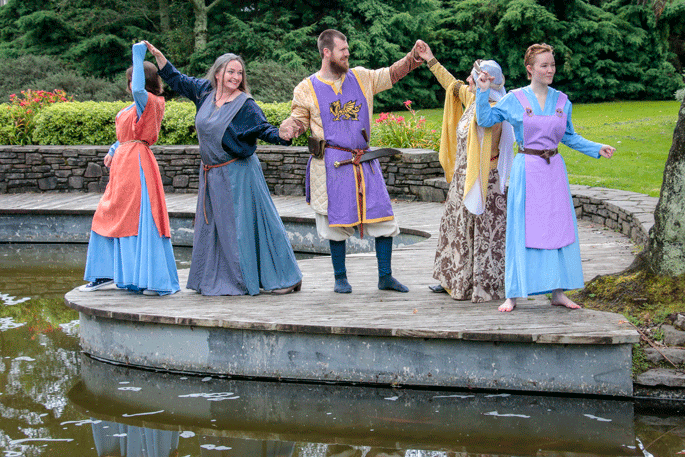Break out your best stockings and tunics, gowns and wimples.
Strike up the harp, the lute and the hammered dulcimer and take your partners for a Maltese bransle.
Yes, a bransle – or a brangle, a brando, a bran or a brantle - depending on who you are dancing with and where you are dancing. Bransle can also mean a brawl, but in this case it's a dignified dance rather than fisticuffs.
The bransle derives from the French verb branier – to shake, waver, sway, wag and wobble. And that's what you do during a bransle – a type of French dance popular from the early 16th century to the present day.
It refers to the side-to-side movement of a circle or chain of dancers holding hands or linking arms.
Bransles were danced by walking, running, gliding, or skipping depending on the speed of the music – all unchoreographed because these traditional or folk dances were about participation rather than a spectacle.
This all leads to the Gate Pa Primary School on Sunday evening, December 16, and again on January 6 and 13.
That's where Ann Dugmore will be holding her medieval dance classes for local serfs and peasants in preparation for the Time Travelling Makers Faire at Southey Field in Tauranga in the middle of January.
There's two types of traditional or medieval dancing - the stately dances for members of court to show off beautiful clothes, and the less refined circle and line dances enjoyed at every festival by peasant villagers. 'Rumbustious, boisterous and unruly – there would be drinking and dancing and food and it would go on for a long time,” says Ann.
And a bit of 'mumming” to boot. 'Mumming dances,” explains Ann. 'They'd wear masks and dance around and do weird things.” The dances combine music, dance and sword fighting around a central theme of death and revival. 'We will be wearing masks on the day.” There's some serious mumming going down at the Time Travelling Makers Faire next month.
'You might also learn The Gay Gordons or Strip the Willow at the dance practices - both traditional folk dances - or even a Morris dance,” says Ann. 'I can hear people now as we talk – Morris dancing, shock horror! But they will be men who will laugh and scoff at things they don't understand.”
She says a lot of men have problems with dancing. 'It would be great if I was proved wrong, but I expect the course will be 99 per cent women.”
Morris dancing, says Ann, is all to do with fertility rites. 'And it's taken quite seriously in England.” That's where she first experienced Morris dancing. 'It all looked a bit ‘jiggy' and energetic at first. But I learned and it extended my repertoire. It's a very traditional form of dancing.”
Very traditional – rhythmic stepping with an earliest recorded mention of 1448.
Or some maypole dancing – a dance celebrating the arrival of spring. Dancers hold ribbons which plait as they intertwine around and away from the maypole.
'The steps are just jigging about,” says Ann, 'and as long as you remember to go over and under with the ribbons, it doesn't require teaching and it's simple enough.
'But it's another thing we will be doing because it's traditional dancing. The faire is always about tradition – traditional crafts, traditional fighting, traditional arts and traditional dancing.”
You might just want to get some pleasurable exercise by joining her for a couple of medieval dance practices. People who attend don't have to perform at the faire. 'That's fine, just come, learn and enjoy,” she says.
So how did Ann Dugmore become Elizabeth of Elmeslac - the medieval name she has taken?
We need to go back to Ann's childhood in England, where she learned traditional folk dancing. 'Then you go on living and don't go back to it.” Not until your 12-year-old goes to a medieval club in Whangarei and wants to learn about sword fighting. 'I sat on the sideline watching him for five minutes and then thought, what the hell, I will get involved.”
The club was wall-to-wall men and she sensed an opportunity - dancing.
'Dancing was important in medieval times,” she says. 'It was one of the rare occasions you could legitimately lay your hands on a woman. It was considered training for knights, because it gave them light footwork to complement their sword fighting skills, and it gave young women an opportunity to show off their figures.
'Forget the idea dancing is only for the young! It has excellent health benefits, keeping your body and mind active and most of all it is fun.”
Ann wants to rekindle that enjoyment. 'A lot of medieval dancing is not choreographed – it can be very repetitive and you are just jigging along in time to the music. It's almost hypnotic, almost spiritual.”
If people are brave enough to wear traditional costumes and dance at the faire, then that would be great. So if you would like to dally a while somewhere between the 5th and 15th centuries, then give Ann (or Elizabeth of Elmeslac) a call on: (07) 578 1919 or message her via: [email protected]
And finally, a glossary for the mildly confused. A wimple is a cloth head dress formerly worn by women and still worn by some nuns. A psaltery is a stringed instrument like a harp and played with the fingers rather than a plectrum. A lute was the instrument of kings and queens, like a mandolin, and the dulcimer is a percussion stringed instrument.



0 comments
Leave a Comment
You must be logged in to make a comment.